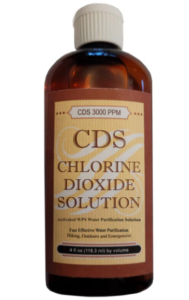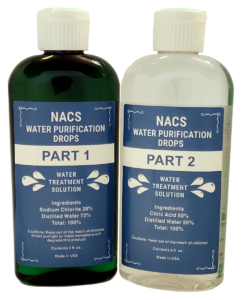Chlorine Dioxide Solution (CDS), or CDS 3000 PPM, is a purified form of chlorine dioxide gas dissolved in water. Developed as an alternative to traditional MMS (Miracle Mineral Solution), CDS eliminates the need for an activator, offering a simpler, more tolerable, and versatile option for various applications. This guide explores its benefits, production, storage, and dosage recommendations.
What is CDS, and How is it Different from MMS?
CDS is a 0.29% chlorine dioxide solution created through a distillation process. Unke MMS, which requires activation with acids like citric or hydrochloric acid, CDS is pre-activated, removing potential issues associated with acid byproducts and excess acidity.
Advantages of CDS 3000:
- Ease of Use:
- CDS eliminates the need for an activator and is ready for immediate use.
- Better Tolerability:
- Minimal odor and improved taste make it easier to consume.
- It significantly reduces the risk of nausea associated with MMS.
- Purity:
- Contains only chlorine dioxide and water, with no residual byproducts.
- Versatility:
- Suitable for intravenous and intramuscular applications in veterinary contexts.
- Consistency:
- Pre-diluted and standardized, reducing user error during preparation.

The Development of CDS
Andreas Kalcker, a biophysicist, developed CDS in response to a request from a calf breeder. Traditional MMS caused gastrointestinal discomfort in calves, leading to the need for a purer, more tolerable solution. By distilling chlorine dioxide gas into cool water, a 0.29% pure solution was achieved.
Production and Safety Considerations
- Distillation Process:
- Chlorine dioxide gas is distilled into water using specialized equipment.
- This process is delicate, as incorrect tube materials can lead to explosions.
- Laypersons should not attempt to produce CDS at home without proper training.
- Storage:
- Store in violet glass bottles for optimal preservation.
- Keep in a cool, dark place (below 11°C, ideally in a refrigerator).
- Exposure to heat, light, or air weakens the solution, as indicated by the fading yellow color.
Using CDS
General Guidelines:
- Cooling Before Use:
- Refrigerate the bottle before opening for the first time or after it has been warmed to prevent chlorine dioxide from escaping.
- Avoid Light and Heat:
- Transport in insulated containers and return to the refrigerator immediately after use.
- Immediate Use:
- Measure drops directly from the bottle into water; do not mix with juices or other beverages.
Applications of CDS
- Oral Use:
- Dilute the required drops in water and consume.
- Topical Use:
- Apply undiluted CDS to the skin or lips. If irritation occurs, rinse immediately.
- Veterinary Use:
- It can be administered intravenously or intramuscularly for animals. Dosage must be carefully determined based on size and condition.
Dosage Recommendations
Starting Doses:
- Begin with 2–5 drops per glass of water and increase gradually:
- Eight drops, ten drops, and higher as needed based on individual tolerance.
- Observe how your body reacts before progressing to higher doses.
Maximum Dosage:
- The highest known tolerable dose is 70 drops in a single intake, but this is not universal.
- For chronic or severe conditions, dosages may reach 30–60 drops per intake, spread across the day.
Experimental Nature:
- Due to variations in strength and individual response, dosage should be adjusted cautiously. Always prioritize comfort and safety.

Comparing CDS 3000 and MMS
| Feature | CDS 3000 | MMS |
|---|---|---|
| Activation | Pre-activated; no acid needed | Requires acid activation |
| Taste and Odor | Mild and tolerable | Strong and often unpleasant |
| Risk of Nausea | Minimal | Higher, especially at higher doses |
| Purity | Only chlorine dioxide and water | Residual byproducts possible |
| Versatility | Suitable for IV and IM use | Oral and topical applications only |

Storage and Shelf Life
- Refrigeration:
- Store below 11°C to maximize potency.
- Exposure:
- Light, heat, and air accelerate the loss of efficacy.
- Shelf Life:
- Effective for up to six months under ideal conditions but degrades over time.
Considerations When Buying CDS
- Purity:
- Ensure it is a distilled chlorine dioxide solution, not a sodium chlorite or powdered derivative.
- Quality Testing:
- Look for products tested for consistent chlorine dioxide content over time.
- Visual Indicators:
- A yellowish hue confirms the presence of chlorine dioxide. A faded color indicates reduced potency.
Success Stories and Applications
Users have reported positive outcomes for various conditions, including:
- Skin Issues: Warts, nail fungus, and eczema.
- Respiratory Conditions: Bronchitis and sinusitis.
- General Infections: Suppurative tonsillitis and herpes labialis.
Veterinary applications have also shown promising results, such as a 65kg dog being cured with multiple high doses.
Challenges and Limitations
- Potency Variability:
- Concentrations can vary across suppliers, requiring careful dosage adjustments.
- Limited Efficacy Over Time:
- Degradation makes precise dosing difficult after prolonged storage.
Chlorine Dioxide Solution (CDS) offers a significant advancement over traditional MMS. Its ease of use, better tolerability, and versatility make it a preferred choice for many users. While challenges remain, such as its shorter shelf life and variable potency, CDS is gaining popularity due to its simplicity and effectiveness. With proper storage and cautious dosage adjustments, CDS can be a powerful health management tool for humans and animals.
For more information on CDS and MMS, see my book, Healthy Alternative Chlorine Dioxide Uses.
~Paris Humble
